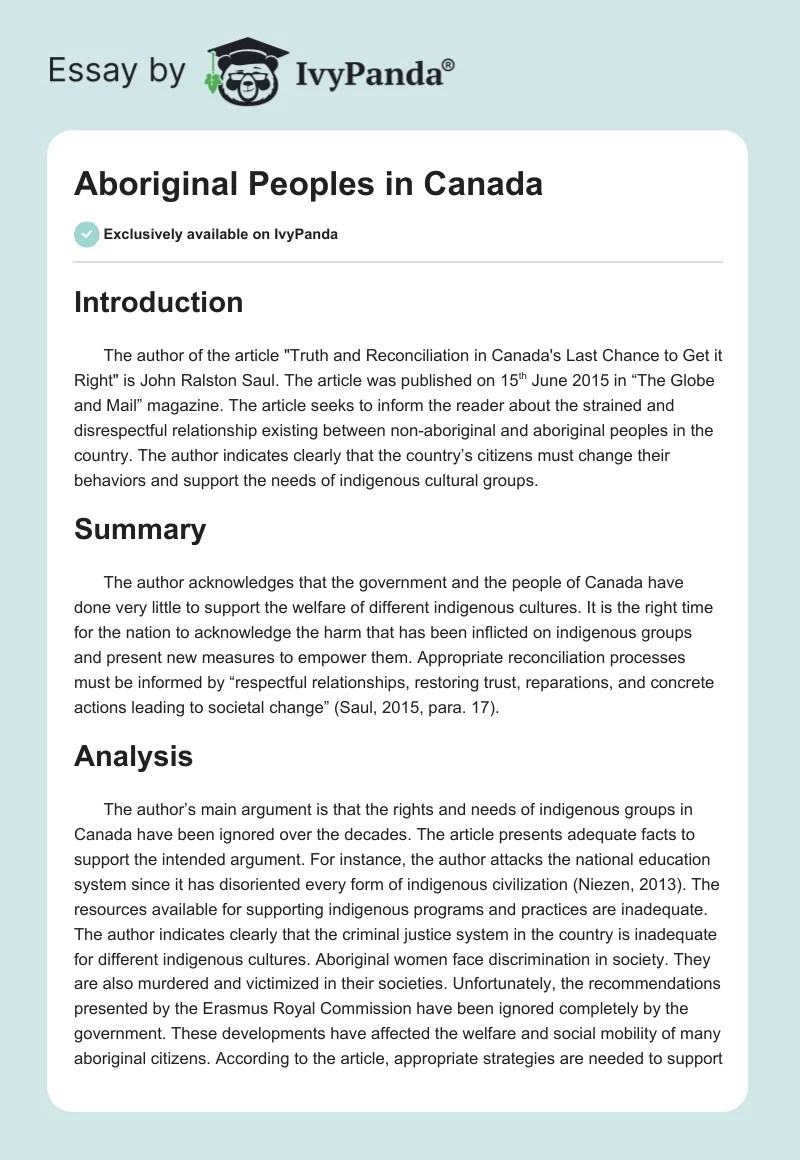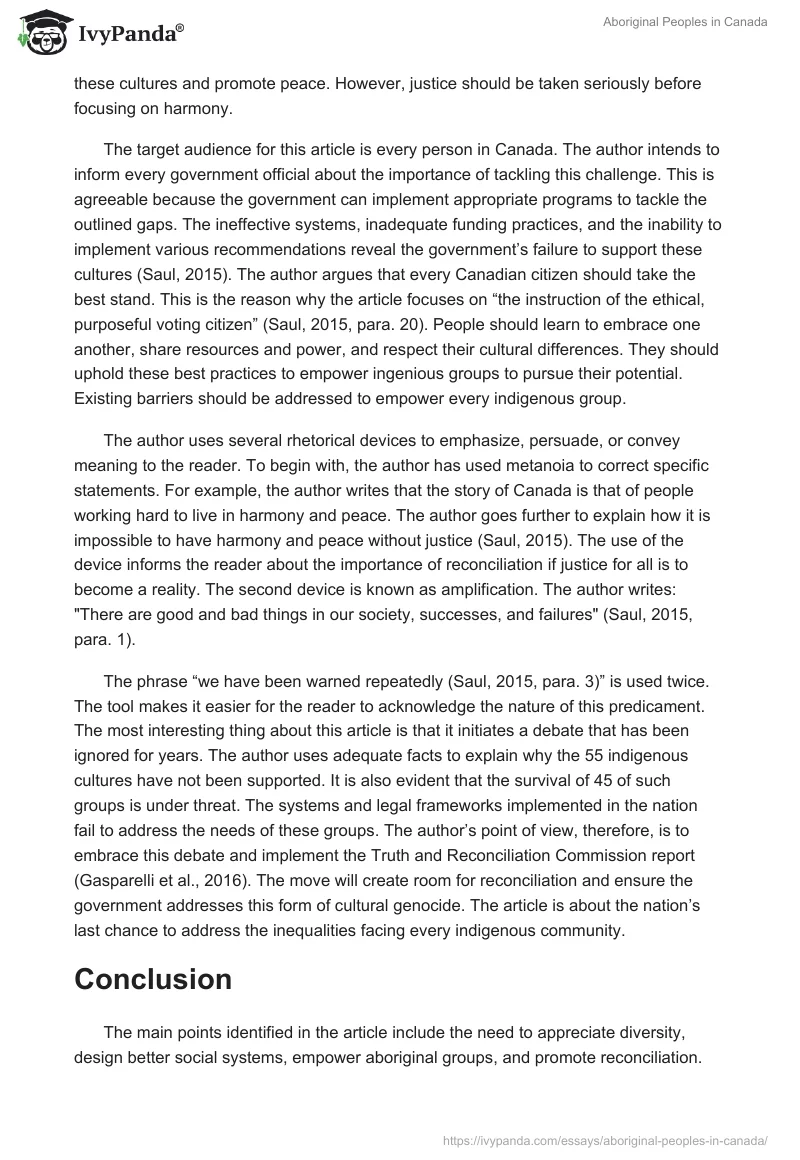Introduction
The author of the article “Truth and Reconciliation in Canada’s Last Chance to Get it Right” is John Ralston Saul. The article was published on 15th June 2015 in “The Globe and Mail” magazine. The article seeks to inform the reader about the strained and disrespectful relationship existing between non-aboriginal and aboriginal peoples in the country. The author indicates clearly that the country’s citizens must change their behaviors and support the needs of indigenous cultural groups.
Summary
The author acknowledges that the government and the people of Canada have done very little to support the welfare of different indigenous cultures. It is the right time for the nation to acknowledge the harm that has been inflicted on indigenous groups and present new measures to empower them. Appropriate reconciliation processes must be informed by “respectful relationships, restoring trust, reparations, and concrete actions leading to societal change” (Saul, 2015, para. 17).
Analysis
The author’s main argument is that the rights and needs of indigenous groups in Canada have been ignored over the decades. The article presents adequate facts to support the intended argument. For instance, the author attacks the national education system since it has disoriented every form of indigenous civilization (Niezen, 2013). The resources available for supporting indigenous programs and practices are inadequate. The author indicates clearly that the criminal justice system in the country is inadequate for different indigenous cultures. Aboriginal women face discrimination in society. They are also murdered and victimized in their societies.
Unfortunately, the recommendations presented by the Erasmus Royal Commission have been ignored completely by the government. These developments have affected the welfare and social mobility of many aboriginal citizens. According to the article, appropriate strategies are needed to support these cultures and promote peace. However, justice should be taken seriously before focusing on harmony.
The target audience for this article is every person in Canada. The author intends to inform every government official about the importance of tackling this challenge. This is agreeable because the government can implement appropriate programs to tackle the outlined gaps. The ineffective systems, inadequate funding practices, and the inability to implement various recommendations reveal the government’s failure to support these cultures (Saul, 2015).
The author argues that every Canadian citizen should take the best stand. This is the reason why the article focuses on “the instruction of the ethical, purposeful voting citizen” (Saul, 2015, para. 20). People should learn to embrace one another, share resources and power, and respect their cultural differences. They should uphold these best practices to empower ingenious groups to pursue their potential. Existing barriers should be addressed to empower every indigenous group.
The author uses several rhetorical devices to emphasize, persuade, or convey meaning to the reader. To begin with, the author has used metanoia to correct specific statements. For example, the author writes that the story of Canada is that of people working hard to live in harmony and peace. The author goes further to explain how it is impossible to have harmony and peace without justice (Saul, 2015). The use of the device informs the reader about the importance of reconciliation if justice for all is to become a reality. The second device is known as amplification. The author writes: “There are good and bad things in our society, successes, and failures” (Saul, 2015, para. 1).
The phrase “we have been warned repeatedly (Saul, 2015, para. 3)” is used twice. The tool makes it easier for the reader to acknowledge the nature of this predicament. The most interesting thing about this article is that it initiates a debate that has been ignored for years. The author uses adequate facts to explain why the 55 indigenous cultures have not been supported. It is also evident that the survival of 45 of such groups is under threat. The systems and legal frameworks implemented in the nation fail to address the needs of these groups.
The author’s point of view, therefore, is to embrace this debate and implement the Truth and Reconciliation Commission report (Gasparelli et al., 2016). The move will create room for reconciliation and ensure the government addresses this form of cultural genocide. The article is about the nation’s last chance to address the inequalities facing every indigenous community.
Conclusion
The main points identified in the article include the need to appreciate diversity, design better social systems, empower aboriginal groups, and promote reconciliation. Justice should be the guiding principle to make the country a better place for all. Reconciliation and justice should be implemented as the last options for addressing the issues facing indigenous groups.
Finally, Canadian citizens and the government should reflect and implement fair programs across the board. This strategy will provide equal opportunities to every group and eventually make the country a better place for every cultural group.
References
Gasparelli, K., Crowley, H., Fricke, M., McKenzie, B., Oosman, S., & Nixon, S. A. (2016). Mobilizing reconciliation: Implications of the Truth and Reconciliation Commission report for physiotherapy in Canada. Physiotherapy Canada, 68(3), 211-212. Web.
Niezen, R. (2013). Canada’s truth and reconciliation commission on Indian residential schools. North York: ON: University of Toronto Press.
Saul, J. R. (2015). Truth and reconciliation in Canada’s last chance to get it right. The Globe and Mail. Web.


